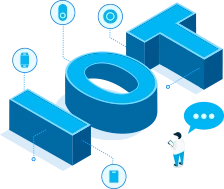In today’s technologically advanced world, wireless communication plays a vital role in connecting people and devices. Among various wireless technologies, Bluetooth Low Energy (BLE), is gaining popularity due to its low power consumption and high efficiency. Bluetooth Low Energy (BLE) beacons have taken the world by storm in recent years. These tiny devices, which use low-power wireless communication technology to transmit data, have found their way into everything from retail stores to airports, museums, and hospitals. But what exactly is BLE, and what makes it so powerful? In this article, we’ll take a deep dive into the world of low-energy Bluetooth beacons and compare LE Bluetooth Beacons with other RF technologies, such as Wi-Fi beacons, Zigbee beacons, RFID beacons, LoRa beacons, NFC beacons, and LTE beacons.
Low Energy Bluetooth Beacons vs. Other RF Beacons
BLE beacon technology has several advantages over other RF (radio frequency) technologies, such as Wi-Fi beacons, Zigbee beacons, RFID beacons, LoRa beacons, NFC beacons, and LTE beacons. The following table compares these RF technologies based on various parameters:
| LOCATION ACCURACY | RANGE | LATENCY | POWER CONSUMPTION | COST | FREQUENCIES | DATA RATE | |
|---|---|---|---|---|---|---|---|
| Low Energy Bluetooth Beacon(BLE Beacon) | Medium to High | 10-100m | Low(100ms+) | Low | Low | 2.4GHz | Up to 2 Mbps |
| WiFi Beacon | High | 30-100m | Low(100ms+) | High | Low to Medium | 2.4GHz/5GHz | Up to 1.3 Gbps |
| Zigbee beacon | Medium | 10-100m | Low(100ms+) | Low | Low to Medium | 2.4GHz/868MHz/ 915MHz | Up to 250 kbps |
| RFID beacon | Low | Up to 100m | Low(ms) | Low | Low to Medium | 125kHz/13.56MHz/ 433MHz/900MHz | Up to 640 kbps |
| LoRa beacon | Medium to High | Up to 15km | High(seconds) | Very Low | Low to High | 433MHz/868MHz/ 915MHz | Up to 50 kbps |
| NFC beacon | Low to Medium | <20 cm | Low(ms) | Very Low | Low to Medium | 13.56MHz | Up to 424 kbps |
| LTE beacon | High | Up to 30km | Medium(ms) | High | High | Various | Up to 1 Gbps |
As you can see, BLE has several advantages over other RF technologies. First, LE Bluetooth Beacons use the 2.4 GHz frequency band, which is an unlicensed frequency band and widely used for wireless communication. Second, it has a longer range than NFC Beacons and RFID beacons, and it consumes less power than Wi-Fi beacons and LTE beacons. Third, it also has a higher data rate than Zigbee beacons and NFC beacons, making it ideal for applications that require faster data transfer. Fourth, the deployment cost of LE Bluetooth Beacons is lower than Wi-Fi and LoRa beacons, making them an economical solution for many applications.
As for beacons based on other RF technologies, we can see that WiFi beacons have a high location accuracy and range but are power-hungry and expensive. ZigBee beacons have low latency and power consumption but have a limited range and data rate. RFID beacons have a low location accuracy but are cheap and have a long range. LoRa beacons have a long range and low power consumption but have a low data rate. NFC beacons have a low to medium location accuracy and range but are very cheap and have a low power consumption. LTE beacons have a high location accuracy and range but are expensive and power-hungry.
Therefore, the choice of which RF beacon to use depends on the application’s specific requirements. For example, BLE beacons may be suitable for indoor location-based services that require low power consumption, while RFID beacons may be suitable for inventory tracking that requires long-range reading.
What is Bluetooth Low Energy (BLE)?
BLE, also known as Bluetooth Smart, is a wireless communication protocol that was introduced by Bluetooth SIG (Special Interest Group) in 2010. It was designed to provide a low-power alternative to traditional Bluetooth, with a focus on battery-operated devices that require long battery life. BLE operates in the 2.4GHz ISM (Scientific, Medical and Industrial) band and has a range of up to 100 meters.
Compared to classic Bluetooth, BLE is simpler and more power-efficient, making it ideal for devices that require a long battery life. It’s also less expensive, which has helped to drive its adoption in various applications.
Technical advantages of Low-Energy Bluetooth Beacons
Low-energy Bluetooth beacons have several technical advantages and features that make them ideal for a wide range of applications. These include:
- Low power consumption: BLE uses very little power, making it ideal for battery-operated devices that are required to operate for long periods of time.
- Simple design: BLE devices are simple to design and manufacture, which makes them less expensive than other wireless communication technologies.
- Compatibility: BLE is compatible with most smartphones and tablets, which makes it easy to integrate into existing systems.
- Security: BLE uses AES-128 encryption, which provides a high level of security and prevents unauthorized access.
- Reliability: BLE is highly reliable and can operate in harsh environments without interference.
- Proximity-based: BLE beacons are proximity-based, which means they can detect nearby devices and trigger actions based on their location.
Working principle of Bluetooth Low Energy Beacons
LE Bluetooth Beacons are small, low-power devices that broadcast a signal at regular intervals. When a nearby device, such as a smartphone or tablet, receives the signal, it can determine its proximity to the beacon. LE Bluetooth Beacons use Bluetooth Low Energy (BLE) technology, which is designed to be energy-efficient and can operate for months or even years on a single battery. LE Bluetooth Beacons are often used with a mobile app or other software that can interpret the beacon’s signal and trigger an action, such as displaying a notification or sending a message.

Technical facts of Low Energy Beacon devices
| Frequency spectrum | 2.4GHz |
| Minimal time to send data | 6ms |
| Maximum radio data rate | 2 Mbps(Bluetooth 5) |
| Connection range | Depends on the selected range mode, used features, and environmental conditions. The regular range is 10-30 meters, however, under ideal conditions, Bluetooth version 5 LE products may connect through about 400 meters |
| Security | In CCM mode-128-bit AES |
| Peak current consumption | Less than 15mA |
| Latency(non-connected > connected state) | 6ms |
How can you use Low-Energy Bluetooth Beacons?
The potential applications of low-energy Bluetooth beacons are vast and diverse. They can be used for asset tracking, Attendance analytics, social distancing tracking, indoor navigation, proximity marketing, inventory management, healthcare, and more.
- In retail, Bluetooth Low energy iBeacon can be used for proximity marketing, allowing stores to send targeted advertisements and promotions directly to a customer’s smartphone. This can result in increased sales and customer engagement.
- In healthcare, low-energy Bluetooth beacons can be used to monitor patient activity, ensuring that they are following their prescribed treatments and adhering to safety guidelines.
- In manufacturing, low-energy Bluetooth beacons can be used to track the movement of goods and equipment, improving inventory management and reducing loss or theft.
- In the hospitality industry, Bluetooth low-energy beacon technology can be used for indoor navigation, allowing guests to easily find their way around hotels or resorts.
- In transportation, they can be used for cold chain and supply chain management.
- In swimming pool: One interesting use case for BLE beacons is in swimming pool monitoring. By installing BLE beacons in different parts of a pool, it is possible to monitor the water quality and temperature, as well as track the movements of swimmers. This information can be used for optimizing pool maintenance and improving safety.
- In Museums and Exhibitions, low-energy beacon technology can help create mobile Tours to quickly find exhibits of interest.

Security and privacy concerns of Bluetooth BLE Beacon
As with any technology, there are potential security and privacy concerns associated with low-energy Bluetooth beacons. The signals emitted by these Bluetooth low energy beacons be intercepted by unauthorized parties, allowing them to track a user’s movements or gain access to sensitive data.
To mitigate these risks, it is important to implement strong encryption and authentication protocols, as well as regularly update the firmware of these beacons to address any security vulnerabilities.
Future development of low power Bluetooth beacon
Low-energy Bluetooth beacons are a key component of the IoT ecosystem. They can be used to connect various devices and sensors so that they can be available to communicate and share data. This can lead to greater efficiency, improved automation, and new insights into business operations. As the demand for IoT devices and solutions continues to grow, it is likely that the use of low-energy Bluetooth beacons will become more widespread. Future developments in this technology may include improved battery life, increased range, and enhanced security features.
Looking ahead, the future of BLE beacons is bright. As technology continues to advance, we can expect to see new applications and use cases emerge, and the demand for BLE beacons to increase. With their low power consumption, small form factor, and versatility, BLE beacons are well-positioned to be a critical technology in the IoT landscape for years to come.
The Low Energy Bluetooth products of MOKOSmart
MOKOSmart is a leading provider of low-energy Bluetooth beacons and other IoT devices. Our range of Bluetooth devices is compatible with iBeacon and Eddystone formats, which can be used in a variety of applications, from asset tracking, indoor navigation, inventory management, cold chain solutions, personnel tracking, etc. Our Bluetooth low energy beacons are designed with different shapes and installations so as to suit various application scenarios.
We pride ourselves on providing high-quality products that are easy to integrate and use. The global certifications we’ve got are UL, CE, RoHS, Reach, ISO9001:2015 and ISO9001:2014, etc. Our team of experts can provide guidance on product selection, customization, and integration, ensuring that our clients have access to customized Bluetooth solutions for their needs.
Conclusion
All in all, low-energy Bluetooth beacons are a powerful RF technology that offers many benefits over other RF technologies. Their low power consumption, small size, and long battery life make them ideal for use in IoT devices and solutions. As the demand for IoT solutions continues to grow, low-energy Bluetooth beacons are likely to play an increasingly important role in the digital landscape. By choosing Mokosmart, clients can be assured that they are working with a trusted and experienced provider of low-energy Bluetooth solutions.
Continue Reading About low energy Bluetooth Beacons






























